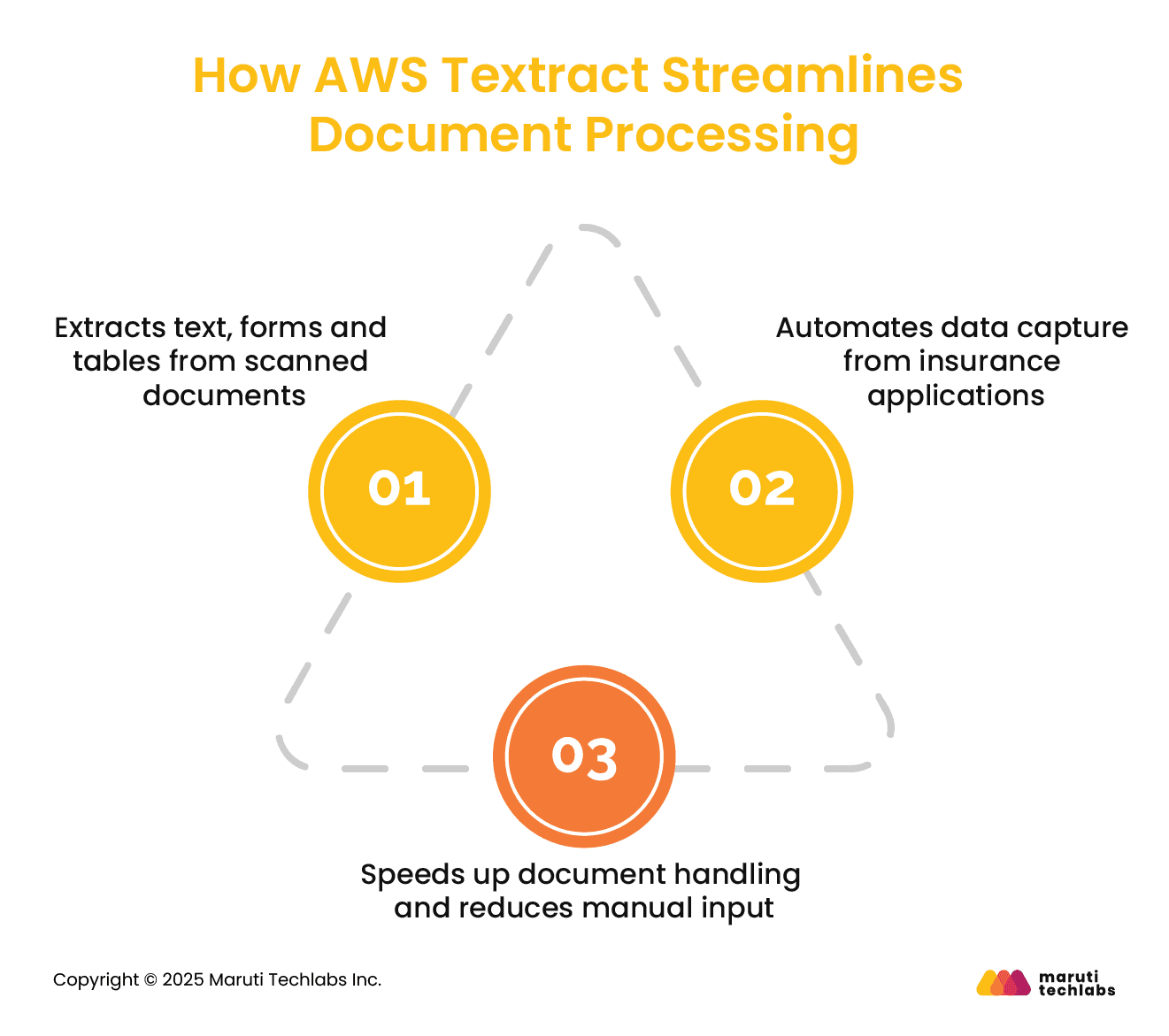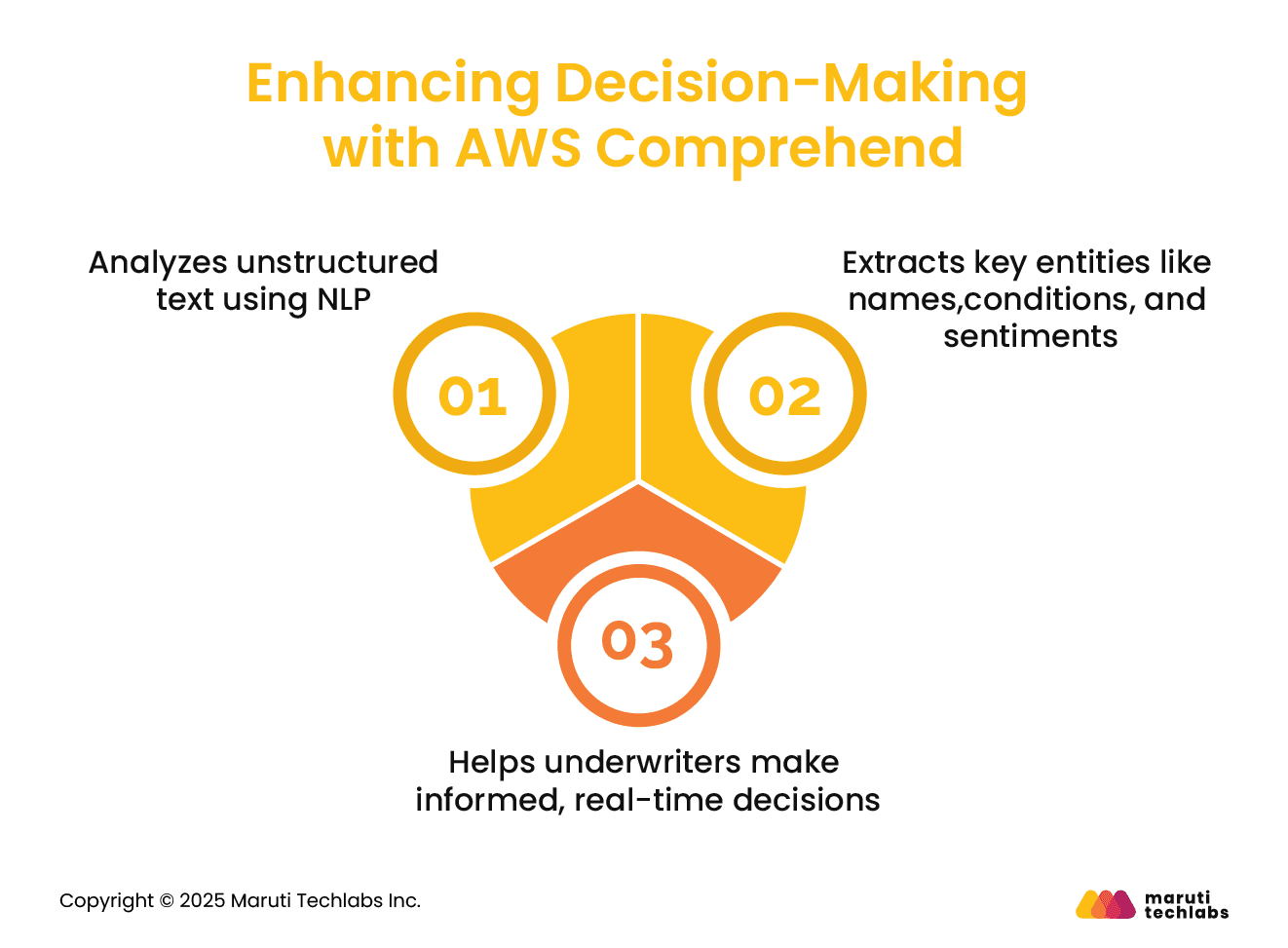

The Ultimate Guide to Automating Underwriting with AWS






Traditional Underwriting is the process of assessing risk, whether for a loan, insurance policy, or investment, to set appropriate terms before moving forward. Traditional underwriting is time-consuming and labor-intensive. Underwriters often review documents manually, leading to delays, inconsistencies, and errors. Applying rules uniformly and explaining decisions can also be challenging.
With the growing adoption of AI and machine learning, the insurance and finance sectors are moving toward more innovative, faster underwriting. Tools like Amazon Textract and Amazon Comprehend make it easier to read and understand information from documents. This helps underwriters work more efficiently, make fewer mistakes, and provide customers with quicker answers.
In this blog, we will discuss automated underwriting, its significance, and how AWS Textract and Comprehend can help build a faster and smarter underwriting process.
Automated insurance or financial underwriting utilizes technology to streamline the review process of applications. Instead of reviewing every document manually, insurers utilize technology to efficiently gather, verify, and analyze the necessary information to make informed decisions. It helps underwriters work more efficiently, reduces manual errors, and brings more consistency to the process.
Customers today expect fast and seamless digital experiences, including when purchasing insurance. Yet few are satisfied with their insurer’s online services. Those under 55, in particular, are likely to switch providers for better digital tools. For insurers, the message is clear: modernize quickly or risk losing customers.
The problem? Manual tasks slow everything down. Underwriters spend a significant portion of their day gathering and entering data, resulting in substantial delays in processes. These delays make it harder to respond quickly to customers or deliver competitive quotes.
With automated tools powered by AI and machine learning, insurers can process large volumes of applications more efficiently and accurately. This means better decisions, fewer delays, and a smoother experience for both underwriters and customers. It’s also a smart move for the future, helping insurers stay competitive, improve profitability, and meet growing expectations.
Insurance paperwork can be tricky. Applications, claims, and reports often come in many formats—some scanned, others handwritten or typed. Going through all of it manually takes time, slows down approvals, and can lead to mistakes. That’s where AWS Textract steps in. It helps insurers process documents more efficiently and with greater accuracy by automatically extracting key information.

Textract doesn’t just scan pages for words. It understands what’s on the page—text, forms, tables, and handwriting. So, whether you’re reviewing a typed report or a scanned handwritten form, Textract can pull out the information in a structured way. For example, it can identify rows in a table or pick up checkboxes from forms, giving you clean, usable data without manual sorting.
This is especially helpful when dealing with large volumes of policy documents, tax forms, or medical records. Instead of flipping through each page and entering data into a system, you can organize and prepare the content in seconds.
Insurance forms require a substantial amount of information, including applicant names, dates, addresses, policy numbers, and more. Textract can automatically locate and extract these fields, regardless of how the document was completed. It even works with scanned copies or forms submitted as PDFs or images.
This relieves the burden on underwriters and admin teams, who would otherwise spend hours reviewing applications line by line. With Textract, the data flows directly into your systems, making the process faster and more consistent.
Textract saves time by reducing manual entry. Instead of copying or typing out details, it pulls the right information from the document in seconds. This not only speeds things up but also reduces human errors.
When documents are handled more efficiently and with fewer errors, customers can make quicker decisions, resulting in a better overall customer experience.
Processing documents is only one part of the job. Understanding the meaning behind the text is what truly helps underwriters make accurate decisions—and quickly. AWS Comprehend helps by turning unstructured text into structured insights using advanced natural language processing (NLP).

Insurance files often contain a mix of emails, reports, notes, and handwritten statements. These aren’t neatly organized fields—they’re paragraphs of information requiring time and attention.
AWS Comprehend utilizes deep learning to analyze this free-form content. It scans large volumes of text, understands the context, and identifies relationships between different elements without manual effort.
Because it’s built on constantly trained models, it continually improves at analyzing real-world language across various domains, including healthcare, finance, and more.
Beyond just reading the text, AWS Comprehend extracts critical details. It can automatically extract names, dates, medical terms, and even policy conditions. It also understands sentiment—like whether a message is written in a positive, negative, or neutral tone.
This kind of insight can help identify risks faster. For example, if a claim report includes negative language or highlights ongoing treatments, underwriters are instantly aware of potential issues they may need to address.
A key advantage is that no deep expertise in natural language processing is required. Simple, well-documented APIs can seamlessly integrate these capabilities into existing systems.
With all this data in hand, extracted and structured, underwriters get the complete picture much faster. They no longer need to spend hours sifting through documents. Instead, they can make informed, consistent decisions backed by real-time analysis.
AWS Comprehend also works well with other AWS services, such as Amazon S3 and AWS Lambda, making it easier to integrate into your existing workflows. With built-in encryption options using your own KMS keys, you maintain complete control over document security.
The ability to analyze millions of documents at scale, without upfront costs or complex setup, enables insurers to move faster, serve customers better, and make smarter decisions with every application.
To automate the underwriting process and eliminate manual document review, here’s how an end-to-end pipeline can be built using AWS:
These services enable insurers to build an efficient, scalable, intelligent document processing workflow that reduces manual effort and accelerates decision-making.
Automating underwriting with AWS Textract and Comprehend unlocks real value for insurers and financial institutions. By replacing manual document review with intelligent data extraction and natural language processing, underwriters can focus on what truly matters—making informed decisions more quickly.
Textract streamlines how insurers handle documents by pulling key data from various formats, while Comprehend takes it further by analyzing context and extracting insights from unstructured text. These tools reduce errors, improve turnaround time, and elevate customer experiences.
One example of this transformation in action is our collaboration with a global auto parts manufacturer, which aims to enhance the accuracy of its demand forecasting. Their existing approach relied heavily on manual inputs and historical averages, often resulting in overstocking or stockouts, particularly for high-volume parts.
We partnered with them to design and deploy a machine learning model on AWS, incorporating historical sales data, seasonality, market trends, and regional demand patterns. This solution reduced prediction errors to within ±20% for high-volume parts.
As a trusted AWS Partner, Maruti Techlabs offers services across cloud migration, optimization, and ML deployment. Get in touch today to discover how our tailored AWS services can help you achieve your business goals.
To ensure your organization is ready to fully leverage AI-driven automation, consider our AI Readiness Assessment Tool. This comprehensive audit identifies your current strengths and areas for improvement, helping your team prepare for successful AI adoption and maximize the benefits of automation. Contact us to start your AI readiness journey.
AWS Textract helps you read and extract information from documents, such as forms, tables, receipts, and ID cards. It works with both typed and handwritten text. You can even ask specific questions to find certain data. It's beneficial for processing invoices, loans, and passports.
Textract makes document handling faster and smarter by converting paper-based information into a format your software can understand and utilize.
Textract utilizes optical character recognition (OCR) to extract text and data from scanned documents, including forms and receipts. Comprehend, on the other hand, analyzes plain text and interprets it, identifying features such as sentiment, key terms, and names of people or places.
Textract focuses on “what’s written,” while Comprehend focuses on “what it means.” Together, they help you extract both raw data and deeper insights from documents and text.
Manual underwriting involves a person reviewing applications, documents, and making decisions. It’s useful for unique or complex cases, but it takes more time.
Automated underwriting uses software to review data and give quicker results based on set rules. It’s faster and more consistent, but might miss small details a human could catch. Both have their place, depending on the level of standardization or complexity of the loan application.
AWS Comprehend is a tool that helps you understand large chunks of text using natural language processing. It can detect key phrases, sentiments, entities, and even the language of the content. You can use it for both real-time and batch analysis, as well as train custom models. Whether analyzing reviews or scanning documents, it helps to quickly and accurately pull out meaningful insights.
Automated underwriting is usually faster and more consistent than manual review. It uses software to apply clear rules, so you know upfront what’s needed. While it may not handle unique cases as flexibly as a human might, it’s excellent for quickly processing large volumes of applications with fewer errors. It’s ideal for straightforward applications, helping lenders make faster decisions.
Automated underwriting is advancing rapidly, often delivering loan decisions in just seconds. Powered by algorithms, it can process information far faster and more efficiently than a human underwriter. For simple applications, you could see results almost instantly. But for more complex cases, it might take longer, depending on the lender’s setup and what kind of loan you’re applying for.


